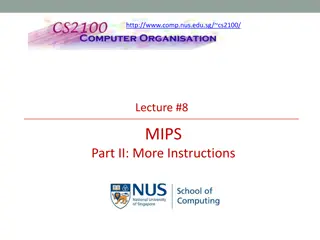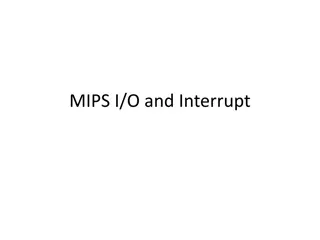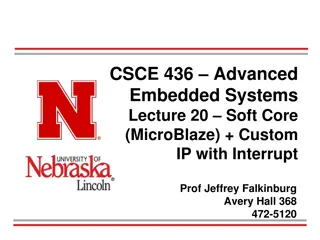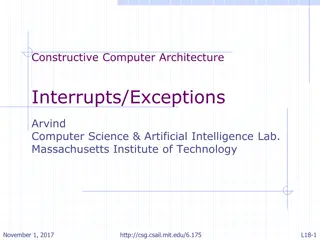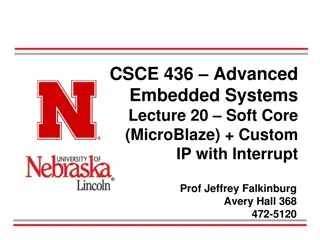Exception Handling and Interrupts in MIPS Architectures
Exception and interrupts in MIPS play a crucial role in handling unexpected events and external requests efficiently. Exceptions include changes in control flow, arithmetic overflows, and hardware malfunctions, while interrupts are externally caused events like I/O requests. When an exception occurs, the system traps it, saves the program counter, runs exception code, and resumes execution. Exception handling involves saving the instruction address, transferring control to the operating system, and potentially stopping or restarting the program. Communication of exception reasons to the OS can be done through status registers or vectored interrupts. Non-vectored exceptions use a single entry point for all exceptions, with the OS decoding the cause from the status register.
Download Presentation

Please find below an Image/Link to download the presentation.
The content on the website is provided AS IS for your information and personal use only. It may not be sold, licensed, or shared on other websites without obtaining consent from the author.If you encounter any issues during the download, it is possible that the publisher has removed the file from their server.
You are allowed to download the files provided on this website for personal or commercial use, subject to the condition that they are used lawfully. All files are the property of their respective owners.
The content on the website is provided AS IS for your information and personal use only. It may not be sold, licensed, or shared on other websites without obtaining consent from the author.
E N D
Presentation Transcript
What are Exception and Interrupts? MIPS terminology Exception: any unexpected change in the internal control flow Invoking an operating system service from user program Integer arithmetic overflow Using an undefined or unimplemented instruction Hardware malfunctions Interrupt: event is externally caused I/O device request Tracing instruction execution Breakpoint (programmer-requested interrupt) 1 January 2014
Exceptions in MIPS stage Problem exceptions occurring Page fault on IF, misaligned memory access, memory protection violation Undefined or illegal opcode IF ID EX Arithmetic exception MEM Page fault on data fetch, misaligned memory access, memory protection violation None WB January 2014 2
What Happens During an Exception? An exception occurs Operating system trap Saving the PC where the exception happens Save the operating system state Run exception code Resume the last instruction before it traps, or terminate the program 3 January 2014
System Exception Handler user program Exception return from exception normal control flow: sequential, jumps, branches, calls, returns 4 January 2014
Exception Handling in Multi-Cycle MIPS Consider two types of exceptions: arithmetic overflow undefined instruction First save the address of the offending instruction in Exception Program Counter (EPC). Transfer control to the operating system (OS) to some specified address. OS provides some service. OS can stop the program or restart the program using EPC. 5 January 2014
Communicating Exception Reason to OS Two methods: Using a status register called Cause Register, holding the reason of exception Using vectored interrupts. The control is transferred to an address determined by the interrupt cause. Vectored interrupts example: Exception Type Exception vector address (in hex) Undefined instruction C000 0000hex C000 0020hex Arithmetic overflow The addresses are separated by 32 bytes (8 instructions). OS performs some limited process. 6 January 2014
Non Vectored Exceptions A single entry point 8000 0180 hex is used for all exceptions. The OS is decoding the status register to find the cause. Two registers are added to the data-path EPC: 32-bit holding the address of the affected instruction. It is required for vectored exceptions too. Cause: 32-bit recording the exception cause (some bits unused). In this example LSB of Cause encodes the exception. EPC must trim 4 from PC. 7 January 2014
Exceptions Handling in Multi-Cycle MIPS 8 January 2014
ALU output overflow. 9 January 2014
Exception in pipelined architecture Force a trap instruction into the pipeline on the next IF Flush the pipeline for the faulting instruction and all instructions that follow After exception handling routine finishes, restore the PC of the saved PC and delay branches if exist 10 January 2014
Additions to MIPS ISA EPC (Exceptional Program Counter) A 32-bit register Holds the address of the offending instruction Cause A 32-bit register Records the cause of the exception Status interrupts mask and enable bits that determines what exceptions can occur. 11 January 2014
Control signals to write EPC , Cause, and Status Be able to write exception address into PC, increase mux set PC to exception address (MIPS uses 8000 00180hex). May have to undo PC = PC + 4, since EPC should point to offending instruction (not to its successor); PC = PC - 4 What else? Flush all succeeding instructions in pipeline 12 January 2014
Additions to MIPS ISA 13 January 2014
Exceptions example 40hex 44hex 48hex 4Chex 50hex 54hex sub $11, $2, and $12, $2, or $13, $2, add $1, slt $15, lw $16, 50($7) $4 $5 $6 $1; // arithmetic overflow $7 $2, $6, Exception handling program: 80000240hex sw 80000244hex sw $25, 1000($0) $12, 1004($0) 14 January 2014
15 January 2014
overflow detected deasserting add flush EX flush ID flush IF nop Clock 6 16 January 2014
first instruction of exception routine Clock 7 17 January 2014
More on Exceptions 18 January 2014
Precise Exceptions If the pipeline can be stopped so that the instructions just before the faulting instruction are completed and the faulting instruction can be restarted from scratch. 19 January 2014
MIPS Exception Mechanism The processor operates in user mode kernel mode Access to additional set of registers and to user mode restricted memory space available when the processor operates in kernel mode. The MIPS architecture includes the notion of co-processors. 20 January 2014
Co-processor Contains registers useful for handling exceptions Not accessible in user mode. Includes the status register, cause register, BadVaddr, and EPC (Exception Program Counter). 21 January 2014
Cause Register The cause register contains information about pending interrupts and the kinds of exception that occurs. 22 January 2014
The contents of the cause register can be copied into an ordinary register and have the individual bits tested to determine what caused an exception to occur. mfc0 $26, $13 The above instruction moves data from coprocessor0 register $13 (cause register) to general purpose register $26 23 January 2014
Status Register The status register contains information about the status of features of the computer that can be set by the processor while in kernel mode 24 January 2014
Exception Program Counter (EPC) Contains the address of the instruction that was executing when the exception was generated. Control can be made to return to this location to continue the program. The contents of EPC can be transferred to a general register via the following instruction mfc0 Rt, $14 25 January 2014
Exception Handler MIPS R32 fixes the starting address of the exception handler to 0x8000 0180. A jump table consists of a list of procedure addresses to be called to deal with the various exception conditions. In an interrupt, the PC had already been incremented and EPC would contain the correct return address. In a syscall, the EPC contains the address of the syscall itself, thus the exception handler must first increment the return address by one before the return. 26 January 2014
Handling an Exception An exception has occurred. What happens? The hardware copies PC into EPC ($14 on cop0) and puts correct code into Cause Reg ($13 on cop0) Sets PC to 0x80000180 enters kernel mode Exception handler (software) Checks cause register (bits 5 to 2 of $13 in cp0) jumps to exception service routine for the current exception 27 January 2014
As with any procedure, the exception handler must first save any registers it may modify, and then restore them before returning to the interrupted program. Saving registers in memory poses a problem in MIPS. Addressing the memory requires a register (base) to form an address. This means that a register must be modified before any register can be saved! The MIPS register usage convention reserves $26 ($k0) and $27 ($k1) for the use of the interrupt handler. 28 January 2014
This means that the interrupt handler can use those without saving them first. A user program that uses those may find them unexpectedly changed! 29 January 2014


